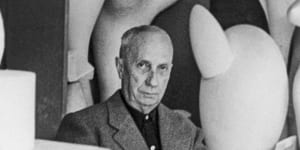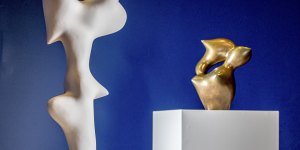The hugely influential artist should be better known than he is in this country. A founder of the Dada movement,which emerged during World War I,his work was also considered surrealist;both were about rejecting tradition and producing radical,experimental art. He is best known for his biomorphic forms,which mirror nature,but he worked across many genres.

Hans Arp in Clamart,1957.André Villiers,Archiv Stiftung Arp e. V.,Berlin
The pieces,ranging in size from 15 centimetres to two metres,include 21 plasters and three bronzes. They are remarkably contemporary,as relevant today as when he made them,particularly given global issues around climate change and the environment.
That timelessness is a reminder about what we learn about the world through the artist’s mind,says Donna McColm,assistant director,curatorial and audience engagement at the NGV. “They show us things that are there but that we haven’t turned our minds to,” she says. “He is certainly asking us to pay attention to nature.”
Born in 1886 in Strasbourg,Arp – who was known as Jean when speaking French and Hans when speaking German – lived and worked in France,Germany and Switzerland. He died in 1966.
In 1925,he exhibited alongside de Chirico,Ernst,Klee,Man Ray,Masson,Miro,and Picasso at the first exhibition of the surrealists at the Paris Galerie Pierre,and soon after staged his first solo exhibition at the Galerie Surrealiste in Paris in 1927. He was part of two major exhibitions at New York’s Museum of Modern Art,including his first US retrospective in 1958.

Installation view of Hans Arp’s Growth (1938,cast 1960) and Crown of buds II (1936,cast circa 1950),part of the NGV’s collection.Tim Carrafa
“The plasters are all him – there’s no studio or other people helping,we see the artist’s hand directly ...[He] worked with this medium because it enabled him to get his thoughts out quite immediately,” says McColm.
By using plaster,Arp was able to make and remake,apply and test modelling and sculpting techniques. The generous donation reflects his widow Marguerite Arp-Hagenbach’s belief that the pieces in this donation are integral to understanding the artist’s work and therefore they should not be sold.
Although a very different media,one of Arp’s marble pieces,Demeter (1960),fetched about $3.4 million in Paris last year. In 2018,.
Created between 1933 and 1966,the donated works will be on display at NGV from 2024. The donation means the gallery will house the most significant holdings of sculptures by Arp in the Asia-Pacific region.
Ten galleries around the world are receiving works by the artist as part of the impressive donation,including the Nasher Sculpture Centre in Dallas and Harvard Art Museums in Cambridge in the United States,the Hepworth Wakefield in Britain,and the remainder in Europe.
The idea behind giving them to an array of venues around the world is to foster research and dialogue about the prolific artist.
McColm saw all 200-odd sculptures to be donated in a major show in Germany last year,before the works were sent around the world. “It was wonderful to see them together – the scale and the colour he achieved,and all the different forms he experimented with,” she says.
Engelbert Büning,director of the artist’s estate,Stiftung Arp e.V.,said the gift to “a carefully selected group of museums” will honour the artist’s processes and legacy.
“Arp’s cultural identity was formed during a long period of charged nationalism;in reaction,the artist refused to confine himself to a single language,nationality,artistic movement or material,” Büning said. “Shifting between abstraction and representation,organic and geometric forms,his work continues to assert the importance of art as a way to break down boundaries.”
The donated works join two pieces already owned by the NGV – a bronze and a plaster – and two of Arp’s woodcuts,featuring nature.
“To be the custodians of this into the future is extraordinary,” McColm says. “Our audiences will love these works;they are highly engaging.”
The Booklist is a weekly newsletter for book lovers from books editor Jason Steger.Get it every Friday.
